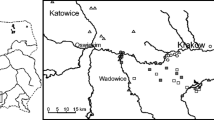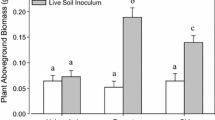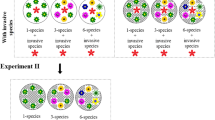Abstract
Increasing evidence suggests that plant invasions are promoted by altered plant-soil interactions. However, we still lack studies exploring differences in the effects of invasive and native species on soil properties, and particularly studies that control for species phylogeny and abundance. Here, we grew seven congeneric pairs of invasive and native species with comparable cover in the studied region in a 12-week common garden experiment. We analyzed the nutrient levels, pH, and composition and abundance of microbial communities in conspecific-conditioned and unconditioned control soil. Then we used ratios of the soil properties in conditioned and control soil to express species effects on the soil. Our findings reveal that invasive species used more phosphorus from the soil and supported mycorrhizal communities with a higher potential to colonize plant roots than native species but these abilities are also dependent on genera. We further observed strong differences among plant genera in many soil properties, and genera from the same families tended to have similar effects on the soil. Furthermore, we found many interactions of genera and invasion status. Effects of plants on the soil were also determined by plant biomass production, independent of species identity. The results suggest that invasive and native species differ only in a few general effects on the soil, and the differences are largely genus specific. They also indicated that species phylogenetic relatedness and individual plant biomass should be considered in future studies on the effect of plants on the soil.




Similar content being viewed by others
References
Adelman MJ, Morton JB (1986) Infectivity of vesicular-arbuscular mycorrhizal fungi: influence of host-soil diluent combinations on MPN estimates and percentage colonization. Soil Biol Biochem 18(1):77–83. https://doi.org/10.1016/0038-0717(86)90106-9
Aldorfová A, Münzbergová Z (2019) Conditions of plant cultivation affect the differences in intraspecific plant-soil feedback between invasive and native dominants. Flora 261:151492. https://doi.org/10.1016/j.flora.2019.151492
Aldorfová A, Knobová P, Münzbergová Z (2020) Plant–soil feedback contributes to predicting plant invasiveness of 68 alien plant species differing in invasive status. Oikos 129(8):1257–1270. https://doi.org/10.1111/oik.07186
Alexander M (1983) Most probable number Method for Microbial populations. In: Page AL (ed) Methods of Soil Analysis: part 2 Chemical and Microbiological Properties. Agronomy Monograph, vol 9, 2nd edn. American Society of Agronomy, Soil Science Society of America, Madison, pp 815–820
Bedini S, Avio L, Sbrana C, Turrini A, Migliorini P, Vazzana C, Giovannetti M (2013) Mycorrhizal activity and diversity in a long-term organic Mediterranean agroecosystem. Biol Fert Soils 49(7):781–790. https://doi.org/10.1007/s00374-012-0770-6
Bever JD, Westover KM, Antonovics J (1997) Incorporating the Soil Community into Plant Population Dynamics: the utility of the Feedback Approach. J Ecol 85(5):561–573. https://doi.org/10.2307/2960528
Burns JH (2004) A comparison of invasive and non-invasive dayflowers (Commelinaceae) across experimental nutrient and water gradients: characteristics of invasive dayflower species. Divers Distrib 10(5–6):387–397. https://doi.org/10.1111/j.1366-9516.2004.00105.x
Caplan JS, Meiners SJ, Flores-Moreno H, McCormack ML (2019) Fine‐root traits are linked to species dynamics in a successional plant community. Ecology 100:e02588. https://doi.org/10.1002/ecy.2588
Chen L, Wang M, Shi Y, Ma P, Xiao Y, Yu H, Ding J (2023) Soil phosphorus form affects the advantages that arbuscular mycorrhizal fungi confer on the invasive plant species, Solidago canadensis, over its congener. Front Microbiol 14:1160631. https://doi.org/10.3389/fmicb.2023.1160631
Chytrý M, Rafajová M (2003) Czech National Phytosociological database: basic statistics of the available vegetation-plot data. Preslia 75(1):1–15
Chytrý M, Tichý L, Dřevojan P, Sádlo J, Zelený D (2018) Ellenberg-type indicator values for the czech flora. Preslia 90(2):83–103. https://doi.org/10.23855/preslia.2018.083
Chytrý M, Danihelka J, Kaplan Z, Wild J, Holubová D, Novotný P, Řezníčková M, Rohn M, Dřevojan P, Grulich V, Klimešová J, Lepš J, Lososová Z, Pergl J, Sádlo J, Šmarda P, Štěpánková P, Tichý L, Axmanová I, Bartušková A, Blažek P, Chrtek J, Fischer FM, Guo W-Y, Herben T, Janovský Z, Konečná M, Kühn I, Moravcová L, Petřík P, Pierce S, Prach K, Prokešová H, Štech M, Těšitel J, Těšitelová T, Večeřa M, Zelený D, Pyšek P (2021) Pladias Database of the czech flora and vegetation. Preslia 93(1):1–87. https://doi.org/10.23855/preslia.2021.001
R Development Core Team (2022) R: A Language and Environment for Statistical Computing. R Foundation for Statistical Computing, Vienna, Austria. http://www.R-project.org/. Accessed 28 Nov 2022
Diniz-Filho JAF, De Sant’Ana CER, Bini LM (1998) An eigenvector method for estimating phylogenetic inertia. Evolution 52:1247–1262. https://doi.org/10.1111/j.1558-5646.1998.tb02006.x
Durka W, Michalski SG (2012) Daphne: a dated phylogeny of a large european flora for phylogenetically informed ecological analyses. Ecology 93(10):2297–2297. https://doi.org/10.1890/12-0743.1
Ehrenfeld JG (2003) Effects of exotic plant invasions on Soil Nutrient Cycling processes. Ecosystems 6(6):503–523. https://doi.org/10.1007/s10021-002-0151-3
Fitzpatrick CR, Gehant L, Kotanen PM, Johnson MTJ (2017) Phylogenetic relatedness, phenotypic similarity and plant-soil feedbacks. J Ecol 105(3):786–800. https://doi.org/10.1111/1365-2745.12709
Florianová A, Hanzelková V, Drtinová L, Pánková H, Cajthaml T, Münzbergová Z (2023) Plant–soil interactions in the native range of two congeneric species with contrasting invasive success. Oecologia 201:461–477. https://doi.org/10.1007/s00442-023-05329-6
García-Sánchez M, Cajthaml T, Filipová A, Tlustoš P, Száková J, García-Romera I (2019) Implications of mycoremediated dry olive residue application and arbuscular mycorrhizal fungi inoculation on the microbial community composition and functionality in a metal-polluted soil. J Environ Manage 247:756–765. https://doi.org/10.1016/j.jenvman.2019.05.101
Grove S, Haubensak KA, Gehring C, Parker IM (2017) Mycorrhizae, invasions, and the temporal dynamics of mutualism disruption. J Ecol 105(6):1496–1508. https://doi.org/10.1111/1365-2745.12853
Herben T, Chytrý M, Klimešová J (2016) A quest for species-level indicator values for disturbance. J Veg Sci 27(3):628–636. https://doi.org/10.1111/jvs.12384
Koyama A, Dias T, Antunes PM (2022) Application of plant–soil feedbacks in the selection of crop rotation sequences. Ecol Appl 32(2):e2501. https://doi.org/10.1002/eap.2501
Kulmatiski A, Beard KH, Stevens JR, Cobbold SM (2008) Plant-soil feedbacks: a meta-analytical review. Ecol Lett 11:980–992. https://doi.org/10.1111/j.1461-0248.2008.01209.x
Kuťáková E, Herben T, Münzbergová Z (2018) Heterospecific plant–soil feedback and its relationship to plant traits, species relatedness, and co-occurrence in natural communities. Oecologia 187(3):679–688. https://doi.org/10.1007/s00442-018-4145-z
Kuťáková E, Mészárošová L, Baldrian P, Münzbergová Z (2020) Evaluating the role of biotic and chemical components of plant-soil feedback of primary successional plants. Biol Fertil Soils 56(3):345–358. https://doi.org/10.1007/s00374-019-01425-z
MacDougall AS, Turkington R (2005) Are invasive species the drivers or passengers of change in degraded ecosystems? Ecology 86(1):42–55. https://doi.org/10.1890/04-0669
McGonigle TP, Miller MH, Evans DG, Fairchild GL, Swan JA (1990) A new method which gives an objective measure of colonization of roots by vesicular-arbuscular mycorrhizal fungi. New Phytol 115(3):495–501. https://doi.org/10.1111/j.1469-8137.1990.tb00476.x
Mehrabi Z, Tuck SL (2015) Relatedness is a poor predictor of negative plant–soil feedbacks. New Phytol 205(3):1071–1075. https://doi.org/10.1111/nph.13238
Meisner A, de Boer W, Verhoeven KJF, Boschker HTS, van der Putten WH (2011) Comparison of nutrient acquisition in exotic plant species and congeneric natives: nutrient acquisition by exotic plant species. J Ecol 99(6):1308–1315. https://doi.org/10.1111/j.1365-2745.2011.01858.x
Moora M, Berger S, Davison J, Öpik M, Bommarco R, Bruelheide H, Kühn I, Kunin WE, Metsis M, Rortais A, Vanatoa A, Vanatoa E, Stout JC, Truusa M, Westphal C, Zobel M, Walther G-R (2011) Alien plants associate with widespread generalist arbuscular mycorrhizal fungal taxa: evidence from a continental-scale study using massively parallel 454 sequencing: invasive plants associate with ubiquitous arbuscular mychorrhizal fungi. J Biogeogr 38(7):1305–1317. https://doi.org/10.1111/j.1365-2699.2011.02478.x
Moore-Kucera J, Dick RP (2008) PLFA profiling of Microbial Community structure and Seasonal shifts in soils of a Douglas-fir chronosequence. Microb Ecol 55(3):500–511. https://doi.org/10.1007/s00248-007-9295-1
Moorman T, Reeves FB (1979) The role of Endomycorrhizae in Revegetation Practices in the Semi-Arid West. II. A Bioassay to determine the Effect of Land Disturbance on Endomycorrhizal populations. Am J Bot 66(1):14. https://doi.org/10.2307/2442619
Moyano J, Dickie IA, Rodriguez-Cabal MA, Nuñez MA (2020) Patterns of plant naturalization show that facultative mycorrhizal plants are more likely to succeed outside their native eurasian ranges. Ecography 43:648–659. https://doi.org/10.1111/ecog.04877
Moyano J, Rodriguez-Cabal MA, Nuñez MA (2021) Invasive trees rely more on mycorrhizas, countering the ideal‐weed hypothesis. Ecology 102:e03330. https://doi.org/10.1002/ecy.3330
Münzbergová Z, Šurinová M (2015) The importance of species phylogenetic relationships and species traits for the intensity of plant-soil feedback. Ecosphere 6(11):1–16. https://doi.org/10.1890/ES15-00206.1
Olsen SR, Sommers LE (2015) Phosphorus. In: Page AL (ed) Methods of soil analysis: part 2 chemical and microbiological properties. American Society of Agronomy, Soil Science Society of America, Madison, WI, USA, p 403–430. https://doi.org/10.2134/agronmonogr9.2.2ed.c24
Onipchenko VG, Zobel M (2000) Mycorrhiza, vegetative mobility and responses to disturbance of alpine plants in the northwestern caucasus. Folia Geobot 35(1):1–11. https://doi.org/10.1007/BF02803083
Pánková H, Dostálek T, Vazačová K, Münzbergová Z (2018) Slow recovery of arbuscular mycorrhizal fungi and plant community after fungicide application: an eight-year experiment. J Veg Sci 29(4):695–703. https://doi.org/10.1111/jvs.12656
Paradis E, Claude J, Strimmer K (2004) APE: analyses of Phylogenetics and Evolution in R language. Bioinformatics 20(2):289–290. https://doi.org/10.1093/bioinformatics/btg412
Perkins LB, Nowak RS (2013) Native and non-native grasses generate common types of plant-soil feedbacks by altering soil nutrients and microbial communities. Oikos 122(2):199–208. https://doi.org/10.1111/j.1600-0706.2012.20592.x
Poorter H, Jagodzinski AM, Ruiz-Peinado R, Kuyah S, Luo Y, Oleksyn J, Usoltsev VA, Buckley TN, Reich PB, Sack L (2015) How does biomass distribution change with size and differ among species? An analysis for 1200 plant species from five continents. New Phytol 208(3):736–749. https://doi.org/10.1111/nph.13571
Pyšek P, Richardson DM (2007) Traits Associated with invasiveness in alien plants: where do we stand? In: Nentwig W (ed) Biol Invasions. Springer, Berlin Heidelberg, Berlin, Heidelberg, pp 97–125. https://doi.org/10.1007/978-3-540-36920-2_7
Pyšek P, Sádlo J, Mandák B (2002) Catalogue of alien plants of the Czech Republic. Preslia 74(2):97–186
Pyšek P, Danihelka J, Sádlo J, Chrtek J, Chytrý M, Jarošík V, Kaplan Z, Krahulec F, Moravcová L, Pergl J, Štajerová K, Tichý L (2012) Catalogue of alien plants of the Czech Republic (2nd edition): checklist update, taxonomic diversity and invasion patterns. Preslia 84(2):155–255
Rice WR (1989) Analyzing tables of statistical tests. Evolution 43(1):223–225. https://doi.org/10.1111/j.1558-5646.1989.tb04220.x
Rodríguez-Caballero G, Caravaca F, Díaz G, Torres P, Roldán A (2020) The invader Carpobrotus edulis promotes a specific rhizosphere microbiome across globally distributed coastal ecosystems. Sci Total Environ 719:137347. https://doi.org/10.1016/j.scitotenv.2020.137347
Sádlo J, Chytrý M, Pyšek P (2007) Regional species pools of vascular plants in habitats of the Czech Republic. Preslia 79(4):303–321
Sokornova S, Malygin D, Terentev A, Dolzhenko V (2022) Arbuscular Mycorrhiza Symbiosis as a factor of Asteraceae Species Invasion. Agronomy 12:3214. https://doi.org/10.3390/agronomy12123214
Soudzilovskaia NA, Vaessen S, Barcelo M, He J, Rahimlou S, Abarenkov K, Brundrett MC, Gomes SIF, Merckx V, Tedersoo L (2020) FungalRoot: global online database of plant mycorrhizal associations. New Phytol 227(3):955–966. https://doi.org/10.1111/nph.16569
Sun Dy Yang X, Wang Y, Fan Y, Ding P, Song X, Yuan X, Yang X (2022) Stronger mutualistic interactions with arbuscular mycorrhizal fungi help Asteraceae invaders outcompete the phylogenetically related natives. New Phytol 236(4):1487–1496. https://doi.org/10.1111/nph.18435
Sweet DD, Burns JH (2017) Plant performance was greater in the soils of more distantly related plants for an herbaceous understory species. AoB Plants 9(1):896. https://doi.org/10.1093/aobpla/plx005
Ter Braak CJF, Šmilauer P (2012) Canoco reference manual and user’s guide: software for ordination, version 5.0. Microcomputer Power, Ithaca, USA
van Grunsven RHA, Yuwati T-W, Kowalchuk GA, van der Putten WH, Veenendaal EM (2014) The northward shifting neophyte Tragopogon dubius is just as effective in forming mycorrhizal associations as the native T. pratensis. Plant Ecol Divers 7(4):533–539. https://doi.org/10.1080/17550874.2013.824517
Vestberg M, Palojärvi A, Pitkänen T, Kaipainen S, Puolakka E, Keskitalo M (2012) Neutral lipid fatty acid analysis is a sensitive marker for quantitative estimation of arbuscular mycorrhizal fungi in agricultural soil with crops of different mycotrophy. Agric Food Sci 21(1):12–27. https://doi.org/10.23986/afsci.4996
Voříšková A, Janoušková M, Slavíková R, Pánková H, Daniel O, Vazačová K, Rydlová J, Vosátka M, Münzbergová Z (2016) Effect of past agricultural use on the infectivity and composition of a community of arbuscular mycorrhizal fungi. Agric Ecosyst Environ 221:28–39. https://doi.org/10.1016/j.agee.2016.01.012
Wang B, Qiu Y-L (2006) Phylogenetic distribution and evolution of mycorrhizas in land plants. Mycorrhiza 16(5):299–363. https://doi.org/10.1007/s00572-005-0033-6
Wei C, Gao L, Tang X, Lu X (2021) Plant evolution overwhelms geographical origin in shaping rhizosphere fungi across latitudes. Glob Change Biol 27(16):3911–3922. https://doi.org/10.1111/gcb.15683
Yannelli FA, MacLaren C, Kollmann J (2020) Moving away from limiting similarity during restoration: timing of arrival and native Biomass are better Proxies of Invasion suppression in Grassland Communities. Front Ecol Evol 8:238. https://doi.org/10.3389/fevo.2020.00238
Zhang P, Li B, Wu J, Hu S (2019) Invasive plants differentially affect soil biota through litter and rhizosphere pathways: a meta-analysis. Ecol Lett 22:200–210. https://doi.org/10.1111/ele.13181
Acknowledgements
We thank M. Lokvencová, I. Jarošincová, I. Chmelařová, M. Chmelař, D. Cmíral, L. Drtinová, and student helpers for their help with establishing, maintaining, and harvesting the experiment and H. Pánková and J. Rydlová for advice regarding AMF analyses. The study was supported by the Czech Science Foundation (project GAČR 19-04902 S). It was also partly supported by RVO 67985939 and the Czech Ministry of Education, Youth and Sports (MŠMT).
Author information
Authors and Affiliations
Corresponding author
Ethics declarations
This study was supported by the Czech Science Foundation (project GAČR 19-04902 S). It was also partly supported by RVO 67985939 and the Czech Ministry of Education, Youth and Sports (MŠMT). Author contributions: VH, AF and ZM designed the study, VH and TC collected the data, and VH with help of ZM and AF performed the statistical analyses and wrote the first draft of the manuscript. The authors declare no conflict of interest. The data analyzed in this study are available in the Supplementary information (Online resource 2).
Additional information
Publisher’s Note
Springer Nature remains neutral with regard to jurisdictional claims in published maps and institutional affiliations.
Supplementary Information
Below is the link to the electronic supplementary material.
Rights and permissions
Springer Nature or its licensor (e.g. a society or other partner) holds exclusive rights to this article under a publishing agreement with the author(s) or other rightsholder(s); author self-archiving of the accepted manuscript version of this article is solely governed by the terms of such publishing agreement and applicable law.
About this article
Cite this article
Hanzelková, V., Florianová, A., Cajthaml, T. et al. Plant genus is a better predictor of plant effects on soil biotic and abiotic properties than plant invasion status. Biol Invasions 26, 119–133 (2024). https://doi.org/10.1007/s10530-023-03162-9
Received:
Accepted:
Published:
Issue Date:
DOI: https://doi.org/10.1007/s10530-023-03162-9




